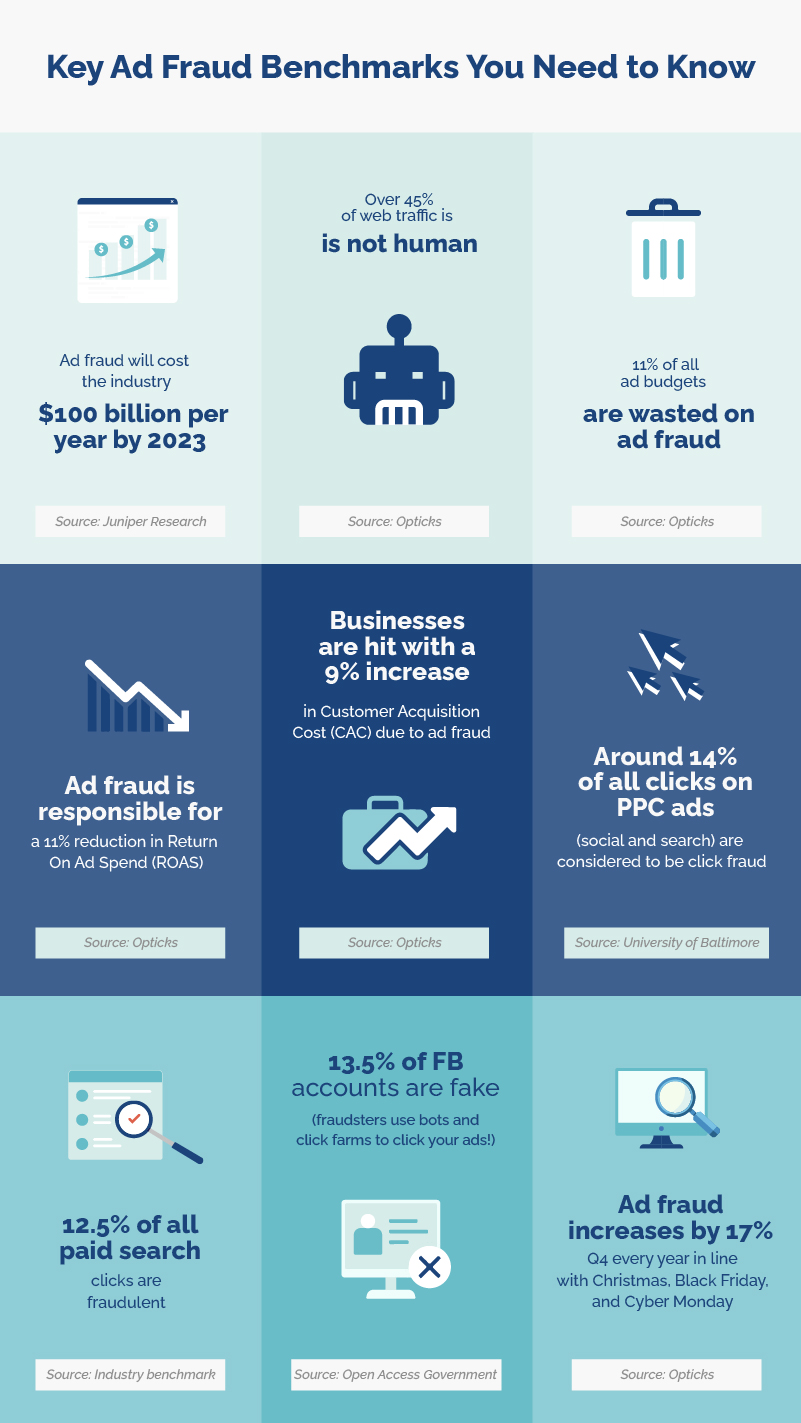When it comes to ad spend, digital media is being prioritized more than ever. Many advertisers, like you, might be aware that ad fraud is detrimental to their ad campaigns, but do you know just how much?
In this article, we take a deep dive into the data and outline the most important ad fraud benchmarks to help marketers understand the severity of the problem and how ad fraud is affecting their marketing efforts.
 Ad fraud’s overall impact across the digital landscape
Ad fraud’s overall impact across the digital landscape
The prevalence of ad fraud has been growing exponentially year on year. While the global cost of ad fraud in 2019 was estimated at $42 billion, this number is expected to almost double to $81 billion in 2022.
And it only stands to get worse:
#1: By 2023, ad fraud will cost the industry $100 billion per year
A report by Juniper Research conducted that by 2023, ad fraud is set to cost the industry $100 billion a year, representing a 2.4X growth compared to 2019.
The rapid growth can be attributed to both the lack of ad fraud regulation across the industry and the inherent complexity and volume of digital advertising.
There still also exists a lack of awareness about the impact of ad fraud across the marketing sector, and often a reluctance to utilize further budgets to tackle it. This overall benchmark, however, shows that marketers can’t afford to ignore ad fraud any longer.
#2: Over 45% of web traffic is not human
Opticks research revealed that more than 45% of web traffic can be attributed to bots. This means that without anti-fraud technology that can analyze, verify, and block ad fraud in real time, companies can never be sure that their ads are actually being seen by humans.
Ad fraud is a direct cause of revenue losses
As well as a lack of awareness about the severity, many marketers have simply accepted ad fraud as a “cost of doing business”. However, revenue losses as a direct result of ad fraud are much more costly than you might think.
#3: 11% of budgets are wasted on ad fraud
Yes, you read that correctly! According to our research, more than a tenth of your ad budget is wasted on ad fraud.
For example: If you are investing $100k per month, you’re losing $11k a month and a total of $132k a year to ad fraud. Not only does that mean that this money isn’t generating any real leads, but your business is also actually handing out free cash to fraudsters one out of every ten times an ad is clicked. To put this into perspective, the amount wasted per year in this example is the equivalent of hiring 2-7 full-time employees (depending on the roles and your location)!
In addition to directly wasted ad budget, you lose yet further money as your sales team is spending time and resources on chasing a few fraudulent dead ends that will never convert.
Ad fraud has a detrimental impact on your most important KPIs
The damage doesn’t stop there though. If 11% of your ad budget is being spent on fraudsters (i.e. non-lucrative actors), then it becomes almost impossible for you to achieve your goals and meet your targets, as your KPIs take a hit too.
#4: Ad fraud causes an 11% reduction in Return On Ad Spend (ROAS)
Our own data demonstrates the devastating effect ad fraud has on your ROAS numbers — as much as a reduction of 11% can be seen in companies with no ad fraud prevention systems in place.
#5: Ad fraud leads to a 9% increase in Customer Acquisition Cost (CAC)
As well as a reduction in ROAS, ad fraud also causes a 9% increase in CAC in companies with no prevention function, which can potentially decimate the success of your campaigns.
The performance of your ad campaigns will also appear worse than they are in reality since ad fraud massively skews the accurate data you’re able to glean.
Ad fraud penetrates all digital advertising channels and campaign types
Although some can prove more lucrative than others, fraudsters don’t discriminate when it comes to which channels and campaign models they target.
#6: An estimated 14% of all clicks on PPC ads (social and search) are considered click fraud
While this doesn’t sound like a huge number, when you consider the sheer amount of PPC ads displayed across the entire internet, the severity soon becomes clear. This estimate was made by an academic report carried out by the University of Baltimore, which also concluded that PPC marketing managers faced losses of up to $23.7 billion due to click fraud in 2020.
The report also detailed the sectors most impacted by click fraud and estimated that over 30% of clicks on ads in the education sector were invalid, while in the tourism/travel sector, it was 16%.
And to further prove that nobody, not even the big guns are immune to ad fraud, Google acknowledged in 2018 that a fraud scheme was able to steal almost $10 million from its ad networks and partners. It was shut down after being revealed by Buzzfeed News.
#7: 12.5% of all paid search clicks (Google, Bing, etc) are fraudulent
This is a commonly known ad fraud benchmark and the problem isn’t going away. Yet, paid search continues to be the most-used digital advertising format, attracting 47% of total digital ad revenues. In 2019, Google search was worth $98 billion, and advertisers continue to allocate more and more of their budget to it
#8: 13.5% of Facebook accounts are fake
Although Facebook pledges to continue to take steps to improve the performance of your ads, it’s not enough.
Of the 2 billion+ Facebook accounts, an estimated 270 million of those are fake or duplicated accounts. Within this group lie the fraudsters using bots and click farms to fraudulently click your ads, which, once again, drains your ad budget and lowers the chances of your ads reaching real, genuinely interested people.
#9: Ads on LinkedIn are not exempt from fraud
LinkedIn’s User Agreement “prohibits the use of bots or other automated fraudulent methods to access their services”. Although data on the exact impact is unavailable, reports indicate that ad fraud still occurs across the platform.
Not only has the platform been sued by a company for ad performance fraud, but an experiment conducted by digital agency RMG produced several alarming results:
- It was found that LinkedIn’s actual vs projected cost per click was wildly inaccurate. In an ad promoting a webinar to US executives at large firms, LinkedIn estimated a $25 average CPC, while the actual campaign CPC was nearly $45 — a staggering 200% more.
- During a $3,000 campaign in March 2020, LinkedIn reported 256 clicks with an average CPC of $11. The company received zero leads from any of the clicks.
While this is based on just a small sample size, it’s obvious that LinkedIn, like any other ad channel, is not free from ad fraud. Moreover, given that it is comparatively more expensive, it’s important to properly track its actual impact on your campaign performance.
Seasonality and trends cause upticks in the prevalence of ad fraud
As marketing teams prepare for seasonal events such as Christmas and Black Friday, so too do fraudsters. While you put together perfectly curated ads for the time of year, fraudsters lie in wait to capitalize on your hard work.
#10: Ad fraud increases by 17% during Q4 every year
The fourth quarter of the year covers Black Friday, Cyber Monday, and Christmas, and according to our proprietary data, exposure to fraud during Q4 is 17 percentual points higher than the rest of the year.
As teams increase their budget to account for a busier season, fraudsters up the ante with their nefarious, budget-stealing ad fraud techniques.
It’s time to take ad fraud benchmarks to heart
You can know these ad fraud benchmarks like the back of your hand — but it’s pointless knowledge if you don’t do anything to prevent ad fraud from damaging everything from campaign performance to budgets.
Looking to stop ad fraud in its tracks? Contact our team or start your free trial today.
